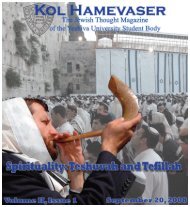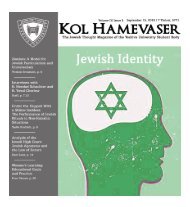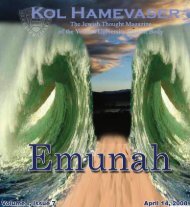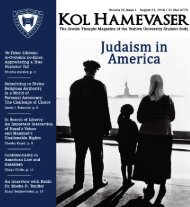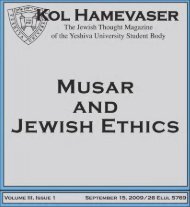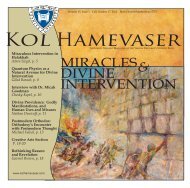Create successful ePaper yourself
Turn your PDF publications into a flip-book with our unique Google optimized e-Paper software.
<strong>Halakhah</strong> <strong>and</strong> <strong>Minhag</strong><br />
Ha-Mahamir, Mah Tavo Alav?: i<br />
Religious Stringencies <strong>and</strong> Their Psychological Considerations<br />
BY: Shlomo Zuckier<br />
From the Talmudic dictum safek de-<br />
Oraita le-humra (in case of doubt concerning<br />
biblically m<strong>and</strong>ated laws,<br />
follow the stringent opinion), ii it seems that Judaism<br />
values religious stringency within its halakhic<br />
framework. The word humra can be<br />
used in several different ways, ranging from<br />
the internal legal examples just discussed to the<br />
term’s more ubiquitous use today, as referring<br />
to personal stringencies not m<strong>and</strong>ated me-ikkar<br />
ha-din (by the basic, st<strong>and</strong>ard law), but which<br />
one takes upon himself for reasons of personal<br />
piety. iii The latter category of individually-accepted<br />
humrot, in terms of the non-halakhic issues<br />
it presents, will be the focus of this article.<br />
There is obviously much halakhic <strong>and</strong>/or<br />
exhortative material germane to this topic,<br />
which will not be pursued in this article. iv Instead,<br />
the article will attempt to analyze certain<br />
psychological <strong>and</strong>/or social considerations that<br />
pertain to the practical application of this subset<br />
of humrot. v It will focus on the individual<br />
level, though many of the points in this article<br />
are also applicable on broader social planes.<br />
As with most things, this analysis will be colored<br />
by the hashkafic <strong>and</strong> religious context to<br />
which its author was party, but the potential issues<br />
<strong>and</strong> considerations are presented from an<br />
impartial perspective <strong>and</strong> should hopefully be<br />
applicable to similar cases in other religious<br />
settings.<br />
Before entering the specific content of<br />
this topic per se, it is important to delineate two<br />
different determinations of humra <strong>and</strong> to orient<br />
the discussion towards one of them. First,<br />
there is the question of defining the ikkar hadin<br />
(basic law) <strong>and</strong> the varying levels of stringency<br />
outside of it, ranging from reasonable<br />
adoption of the minority practice in the writings<br />
of Rishonim to practices with little to no<br />
basis in the primary sources. The established<br />
range of opinions will depend on the Talmudic<br />
sugya <strong>and</strong> its Rishonim, along with a responsible<br />
<strong>and</strong> serious study of the Shulhan Arukh<br />
<strong>and</strong> its attendants, discriminating between<br />
Ashkenazi <strong>and</strong> Sefaradi decisors when applicable<br />
<strong>and</strong> accompanied by an analysis of contemporary<br />
posekim on the issue, can yield the<br />
determination of what is ikkar ha-din <strong>and</strong> what<br />
is considered a legal humra. vi Second, there is<br />
the question of current practice in one’s community<br />
<strong>and</strong> of what qualifies as a sociological<br />
humra, a practice more stringent than that of<br />
the common man in one’s surroundings. This<br />
will depend on the country one lives in, <strong>and</strong>,<br />
more specifically, his community, whether that<br />
is determined by the neighborhood in which<br />
one resides or the shul or yeshivah he frequents.<br />
vii The sociological humra is usually<br />
more relevant in the context of analyzing one’s<br />
psychological relation to humrot, as the<br />
strongest frame of reference for most people is<br />
social.<br />
Now that the categories have been demarcated,<br />
an analysis of the psychological ramifications<br />
of the humra can be undertaken,<br />
“He has gone beyond the call of duty in his<br />
adherence to God’s Law, <strong>and</strong> he therefore often<br />
feels a true <strong>and</strong> sincere sense of religious<br />
accomplishment for that.”<br />
beginning with its positive consequences. In<br />
order to minimize tangential issues, let us analyze<br />
the case of someone keeping a humra that<br />
has significant basis in rabbinic sources but is<br />
not usually followed in his sociological context.<br />
As stated above, this section will leave out<br />
the pure halakhic benefits of following a<br />
humra, namely one’s increased chances of<br />
properly fulfilling the mitsvah or avoiding the<br />
aveirah (the validity of these claims may depend<br />
on one’s underst<strong>and</strong>ing of pesak <strong>Halakhah</strong><br />
<strong>and</strong> one might split between the two<br />
categories), among other issues, which are of<br />
extreme significance but beyond the scope of<br />
this discussion.<br />
The first psychological effect of humra<br />
observance is arguably the most obvious one.<br />
The mahamir, aware that the posekim often<br />
call for a ba’al nefesh (a spiritual person) to be<br />
stringent <strong>and</strong> of the yeshivah world’s cultural<br />
admiration for such practices, presumably feels<br />
a stronger sense of personal religious identity<br />
as a result of his observances. He has gone beyond<br />
the call of duty in his adherence to God’s<br />
Law, <strong>and</strong> he therefore often feels a true <strong>and</strong> sincere<br />
sense of religious accomplishment for<br />
that. Falling into the category of a ba’al nefesh,<br />
then, is the first <strong>and</strong> most salient positive<br />
effect of observing humrot. Conversely, it is<br />
possible that one who only follows the letter of<br />
the law <strong>and</strong> never goes a step beyond may feel<br />
a sense of mediocrity. If his religious observance<br />
is equivalent to everyone else’s <strong>and</strong> incorporates<br />
no extraordinary initiatives, he may<br />
appear spiritually deficient in his own eyes. Of<br />
course, some people are satisfied by simply<br />
fulfilling the shurat ha-din (line of the law) <strong>and</strong><br />
see that as a worthy religious goal <strong>and</strong> ideal.<br />
But many others feel drawn to the idea of halakhic<br />
maximalism <strong>and</strong> disappointed when<br />
they fall short of achieving it.<br />
Another relevant factor is that of personal<br />
investment. One who decides to observe a<br />
humra within a particular din (law) or number<br />
of dinim based on his personal research <strong>and</strong> assessment<br />
of the issues feels a stronger connection<br />
to that din than one who follows the<br />
st<strong>and</strong>ard practice. We do not generally favor<br />
any one mitsvah over another, viii but a person<br />
who attaches himself to one mitsvah in particular<br />
<strong>and</strong> reflects that connection by following<br />
certain humrot therein will improve his overall<br />
religious observance. The halakhic system is<br />
one which of necessity permits little personal<br />
input, so humrot represent an arena that allows<br />
for individual expression <strong>and</strong> an increased<br />
bond to mitsvot. Assuming these extra, voluntary<br />
levels of observance are part of a healthy,<br />
broader life of religious commitment, the excitement<br />
<strong>and</strong> abundant energy generated by<br />
keeping a particular favored din in the best way<br />
possible can spill over <strong>and</strong> affect the rest of that<br />
person’s religious world as well. ix Of course,<br />
this idea of personal investment in a mitsvah<br />
on account of a specific humra is lost in a society<br />
in which everyone follows that humra.<br />
For example, in a place where everyone keeps<br />
chalav Yisrael (milk whose processing was<br />
performed under Jewish supervision), the personal<br />
investment factor is negligible; one’s observance<br />
is based on communal expectation,<br />
not personal motivation <strong>and</strong> attachment.<br />
Nevertheless, not everything about humrot<br />
is positive; the same mechanism which has<br />
the power to positively affect the religious Jew<br />
also has the potential to backfire. These pitfalls<br />
are by no means inevitable, <strong>and</strong> it is more<br />
than possible to steer clear of them, but it is important<br />
to be aware of them. One of the most<br />
dangerous snares in this area is the potential<br />
for losing focus on <strong>and</strong> underst<strong>and</strong>ing of the<br />
proper weight of different halakhic <strong>and</strong><br />
hashkafic issues. The mahamir runs the risk<br />
of preferring the tafel (secondary) to the ikkar<br />
(primary), the shittat yahid (unaccepted minority<br />
position) to the basic din. In his rush towards<br />
halakhic maximalism, he may skip steps<br />
<strong>and</strong> not sufficiently concentrate on the more<br />
basic halakhic requirements. Mental energy<br />
expended on being makpid (meticulous) on<br />
humrot might be better employed reinforcing<br />
more basic religious obligations. Indeed, at<br />
times it may be the case that someone accepts<br />
upon himself extra religious observances in<br />
Volume III, Issue 7 www.kolhamevaser.com<br />
one area in order to assuage his guilt over religious<br />
failings in other areas, but this approach<br />
fails to treat the root of the problem itself.<br />
Excessive humra observance not only affects<br />
mental focus, but issues of material allocation<br />
as well. Money spent on more<br />
expensive meat with an extra hekhsher (kosher<br />
certification) cannot be used for tsedakah<br />
(charity) purposes. Similarly, time spent working<br />
out practicalities related to a certain hakpadah<br />
(self-imposed restriction) cannot<br />
simultaneously be applied towards acts of<br />
hesed (kindness) or other mitsvot. In fact,<br />
there are certain cases where a humra indirectly<br />
blocks certain other desirable religious<br />
goals, including cases where those who refrain<br />
from eating certain foods find their ability to<br />
be me’urav im ha-beriyyot (involved with people)<br />
compromised. As some like to say, x every<br />
humra is also a kulla, in the sense that the extra<br />
effort (of whatever form) utilized in order to<br />
promote a particular religious observance beyond<br />
the letter of the law necessarily mitigates<br />
one’s ability to pursue other religious goals <strong>and</strong><br />
quests.<br />
An oft-discussed side-effect of humrot is<br />
the dangerous <strong>and</strong> undercutting yohara (presumptuousness)<br />
that it can induce. Yohara is<br />
discussed in several places in the Gemara xi <strong>and</strong><br />
it casts a significant shadow in the works of the<br />
commentaries <strong>and</strong> posekim as well. xii The<br />
more widespread underst<strong>and</strong>ing of this phenomenon<br />
is that the mahamir may feel a certain<br />
arrogance <strong>and</strong> sense of self-importance as<br />
a result of his increased religious observance<br />
<strong>and</strong> willingness to go beyond the letter of the<br />
law. This is definitely a potentially significant<br />
problem, <strong>and</strong> one should always be cautious<br />
“Even if the person does not feel that he is acting<br />
for inappropriate reasons, the very fact that his<br />
humrot are incongruous with his general<br />
religious practice is reason enough to<br />
render this behavior inappropriate.”<br />
not to apply his religious observance as a psychological<br />
kardom lahpor bo (utility). xiii<br />
However, presumptuousness is not the<br />
only meaning of yohara; one need not project<br />
a pompous aura in order to fail the yohara test.<br />
If the mahamir is keeping a humra that is out<br />
of whack with his level of general religious observance,<br />
if his reach ventures far beyond his<br />
grasp, then this internal inconsistency itself<br />
may qualify as yohara. xiv Even if the person<br />
does not feel that he is acting for inappropriate<br />
reasons, the very fact that his humrot are incongruous<br />
with his general religious practice<br />
is reason enough to render this behavior inap-<br />
11



